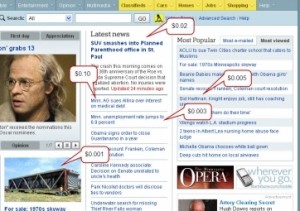 You can skip roughly the first 1,500 words of Jon Austin’s lengthy essay on The Rowdy Crowd and jump right to the nut graph about micropayments. This otherwise rambling opinion piece makes a persuasive case that the news business can create a viable economic model by charging small amounts for each item of content a reader consumes. We’re not talking 25 cents here; we’re talking ¼ of a cent. The technology actually exists to charge very small amounts for very focused transactions, Austin writes, and the newspaper industry could be the first with sufficient motivation to make the system work.
You can skip roughly the first 1,500 words of Jon Austin’s lengthy essay on The Rowdy Crowd and jump right to the nut graph about micropayments. This otherwise rambling opinion piece makes a persuasive case that the news business can create a viable economic model by charging small amounts for each item of content a reader consumes. We’re not talking 25 cents here; we’re talking ¼ of a cent. The technology actually exists to charge very small amounts for very focused transactions, Austin writes, and the newspaper industry could be the first with sufficient motivation to make the system work.
Micropayments were an idea that came out of the early Internet. The idea was that electronic networks removed so much cost from a transaction that it was theoretically possible to conduct profitable exchanges at prices of as little as a few cents. The cell phone companies have been doing this for years by debiting transactions against a buyer’s phone bill. Now Apple is selling iPhone software applications for as little as 99 cents. It’s not a big step from there to ask readers to pay a few pennies to get an article they can’t find anywhere else. People are already comfortable with carrying around their Starbucks and McDonald’s cards and charging small transactions against them. Why can’t the same thing work for information?
The Economist suggests a similar idea in a short column that suggests that consumers may be more willing to pay than one would think I they didn’t have a choice. “Few people would have guessed how much British viewers would be prepared to pay to watch televised football matches—which used to be on free-to-view channels—before Mr Murdoch’s satellite television bought up the rights and began charging,” says the unnamed editorialist. The piece also quotes Los Angeles Times editor Russ Stanton, saying that the paper’s online revenues now pay for the entire print and online editorial staff, a claim we hadn’t seen before. This makes print officially a loss leader at the LA Times.
It seems to us that micropayments are worth another look. If a consortium of publishers could agree to share the costs and to firewall some of their content this way, the technology just might have a chance to generate a meaningful revenue stream for publishers whose local content is truly exclusive.
Le Lockout
“Photographers and journalists at the paper make an average salary of $88,000 for a 30-hour week. Editors make an annual average salary of $125,000. Employees are entitled to four to six weeks of annual vacation paid at time-and-a-half.” Sound like paradise? Actually, the union is pretty unhappy with the state of affairs at Le Journal de Montreal and a contract dispute with management led to a lockout over the weekend. Management charges that the union refuses to negotiate a contract in good faith, and this has frustrated modernization efforts. Union leaders charge that parent company Quebecor Media’s plans to merge Le Journal’s online presence with the media conglomerate’s other holdings will debase the quality of journalism. We can’t remember a newspaper union ever making that a bargaining issue before, particularly at a time of crisis.
Miscellany
Writing on the Knight Digital Media Center, David Westphal suggests that newspapers could tap into foundation grants to shore up their investigative journalism practices. Noting that the Knight Foundation recently gave $5 million to 21 civic foundations for projects that sounded strikingly like local news operations, Westphal suggests that public/private partnerships could enable newspapers to tap in to grants made to local civic organizations and fund projects that would be otherwise unsustainable. It turns out that philanthropies aren’t as resistant to the idea as you might think. Westphal quotes sources at the J-Lab at American University saying the lab has already funded 120 pilot projects with mainstream news organizations. He also quotes the president of the American Society of Newspaper Editors saying the idea deserves discussion.
 A couple of big asset deals may be about to go down. PaidContent.org reports that The New York Times Co. is close to selling 19 of the 25 floors of its new headquarters building in Manhattan to an investment management firm. We weren’t even aware that there were any investment management firms left. The deal would reportedly have W.P. Carey & Co. buying the space and leasing them back to the Times. In a sign of how screwy the real estate business is, the Times Co. would retain ownership of the six floors it doesn’t occupy. PaidContent also says Tribune Co. is mulling a $900 million offer for the Chicago Cubs from the Ricketts family. The offer is the best of the three Tribune has received. Even if it’s successful, approvals and financing could take months.
A couple of big asset deals may be about to go down. PaidContent.org reports that The New York Times Co. is close to selling 19 of the 25 floors of its new headquarters building in Manhattan to an investment management firm. We weren’t even aware that there were any investment management firms left. The deal would reportedly have W.P. Carey & Co. buying the space and leasing them back to the Times. In a sign of how screwy the real estate business is, the Times Co. would retain ownership of the six floors it doesn’t occupy. PaidContent also says Tribune Co. is mulling a $900 million offer for the Chicago Cubs from the Ricketts family. The offer is the best of the three Tribune has received. Even if it’s successful, approvals and financing could take months.
Tim Windsor, who’s newly blogging at Nieman Journalism Lab, points us to a veteran journalist with the delightfully ethnic name of Gina Chen who’s got a terrific how-to blog called Save the Media. Gina exhorts journalists to dive in and start using tools like Facebook and Twitter. She also offers advice to make those tools a little less intimidating. Her plain-talk style is easy to read and she understands the journalist’s perspective. She joins our blog roll and we recommend you bookmark her site.
The Port of Belfast, Northern Ireland, is bullish on newspapers. Or at least bullish on newsprint. It will spend £4.5 million (about $6.1) expanding its paper and newsprint handling facilities. “From nothing just ten years ago, paper imports are now an important part of the port’s diversified trade base,” said the port’s chief executive.
Terence Walsh of the Frederick (Md.) News-Post gets caught up in Obamania, asserting that the new president “has inspired more people, especially young people, to pay attention to the world around them and serve their communities than any politician in recent memory.” He believes this is a rare opportunity for newspapers to reassert their value to young people who are newly energized to learn about the world around them. We hope he’s right, thought ungluing young people’s eyes from their Facebook news feed might be a bigger task than editors imagine.
Class act: The weekly Town Meeting of Elk Rapids (Mich.) shut down after more than 30 years last week. It announced its closure in a two-sentence ad on page 2 of its final edition: “Today marks the final issue of the Town Meeting. We appreciate your loyalty over the 30-plus years the Town Meeting has served your community.”
And Finally…
Chris Freiberg started a Facebook group asking people to buy a newspaper on Groundhog Day (Feb. 2) as a way of showing support for the industry. He invited 600 friends and word-of-mouth has since swelled acceptance to more than 14,000 people. It’s a nice endorsement for a beleaguered industry, but you do have to read some of the raw and funny wall posts.
Comments
This entry was posted on Monday, January 26th, 2009 at 9:24 am and is filed under Facebook, Hyper-local, Solutions. You can follow any responses to this entry through the RSS 2.0 feed. Both comments and pings are currently closed.



[…] I should also mention this website, newspaperdeathwatch.com, which should give you more ideas on the decline of newspapers and the rebirth of journalism. […]
“Rambling”? C’mon! It’s pure gold there, no filler! 🙂
Thanks for reading.
Jon Austin
[…] entertainment value (and very thoughtful chain of comments), or save yourself half an hour with Paul Gillin’s summation, or Austin’s own: Let me wrap up by reviewing the preceding 4,543 words: 1) journalism is not […]